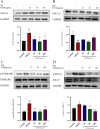A network pharmacology approach to decipher the mechanism of total flavonoids from Dracocephalum Moldavica L. in the treatment of cardiovascular diseases
- PMID: 38169375
- PMCID: PMC10759627
- DOI: 10.1186/s12906-023-04316-x
A network pharmacology approach to decipher the mechanism of total flavonoids from Dracocephalum Moldavica L. in the treatment of cardiovascular diseases
Abstract
Aim of the study: Cardiovascular disease (CVD) seriously endangers human health and is characterized by high mortality and disability. The effectiveness of Dracocephalum moldavica L. in the treatment of CVD has been proven by clinical practice. However, the mechanism by which DML can treat CVD has not been systematically determined.
Materials and methods: The active compounds in DML were screened by literature mining and pharmacokinetic analysis. Cytoscape software was used to construct the target-disease interaction network of DML in the treatment of CVD. Gene ontology and signalling pathway enrichment analyses were performed. The key target pathway network of DML compounds was constructed and verified by pharmacological experiments in vitro. A hydrogen glucose deprivation/reoxygenation model was established in H9c2 cells using hypoxia and glucose deprivation for 9 h combined with reoxygenation for 2 h. The model simulated myocardial ischaemic reperfusion injury to investigate the effects of total flavonoids of Cymbidium on cell viability, myocardial injury markers, oxidative stress levels, and reactive oxygen radical levels. Western blot analysis was used to examine NOX-4, Bcl-2/Bax, and PGC-1α protein expression.
Results: Twenty-seven active components were screened, and 59 potential drug targets for the treatment of CVD were obtained. Through the compound-target interaction network and the target-disease interaction network, the key targets and key signalling pathways, such as NOX-4, Bcl-2/Bax and PGC-1α, were obtained. TFDM significantly decreased LDH and MDA levels and the production of ROS and increased SOD activity levels in the context of OGD/R injury. Further studies indicated that NOX-4 and Bax protein levels and the p-P38 MAPK/P38 MAPK andp-Erk1/2/Erk1/2 ratios were suppressed by TFDM. The protein expression of Bcl-2 and PGC-1α was increased by TFDM.
Conclusions: Our results showed that DML had multicomponent, multitarget and multichannel characteristics in the treatment of CVD. The mechanism may be associated with the following signalling pathways: 1) the NOX-4/ROS/p38 MAPK signalling pathway, which inhibits inflammation and reactive oxygen species (ROS) production, and 2) the Bcl-2/Bax and AMPK/SIRT1/PGC-1α signalling pathways, which inhibit apoptosis.
Keywords: Cardiovascular disease; Network pharmacology; Pharmacological evaluation; Recombinant NADPH oxidase 4; Total Flavonoids from Dracocephalum Moldavica L.
© 2023. The Author(s).
Conflict of interest statement
The authors declare that the research was conducted in the absence of any commercial or financial relationships that could be construed as a potential conflict of interest.
The authors declare no competing interests.
Figures










Similar articles
-
A network pharmacology approach to decipher the total flavonoid extract of Dracocephalum Moldavica L. in the treatment of cerebral ischemia- reperfusion injury.PLoS One. 2023 Jul 26;18(7):e0289118. doi: 10.1371/journal.pone.0289118. eCollection 2023. PLoS One. 2023. PMID: 37494353 Free PMC article.
-
[Effects of total flavonoids of Dracocephalum moldavica on apoptosis of H9c2 cells induced by OGD/R injury and endoplasmic reticulum stress].Zhongguo Zhong Yao Za Zhi. 2025 Mar;50(5):1321-1330. doi: 10.19540/j.cnki.cjcmm.20241212.703. Zhongguo Zhong Yao Za Zhi. 2025. PMID: 40350915 Chinese.
-
Identification of miRNA and Their Regulatory Effects Induced by Total Flavonoids From Dracocephalum moldavica in the Treatment of Vascular Dementia.Front Pharmacol. 2021 Dec 6;12:796628. doi: 10.3389/fphar.2021.796628. eCollection 2021. Front Pharmacol. 2021. PMID: 34938197 Free PMC article.
-
Dexmedetomidine protects against oxygen-glucose deprivation/reoxygenation injury-induced apoptosis via the p38 MAPK/ERK signalling pathway.J Int Med Res. 2018 Feb;46(2):675-686. doi: 10.1177/0300060517734460. Epub 2017 Dec 6. J Int Med Res. 2018. PMID: 29210287 Free PMC article.
-
Total flavones of Dracocephalum moldavica L. protect astrocytes against H2O2-induced apoptosis through a mitochondria-dependent pathway.BMC Complement Med Ther. 2020 Mar 12;20(1):78. doi: 10.1186/s12906-020-2846-4. BMC Complement Med Ther. 2020. PMID: 32164676 Free PMC article.
Cited by
-
A Comprehensive Review of the Phenolic Compounds in Dracocephalum Genus (Lamiaceae) Related to Traditional Uses of the Species and Their Biological Activities.Molecules. 2025 Apr 30;30(9):2017. doi: 10.3390/molecules30092017. Molecules. 2025. PMID: 40363822 Free PMC article. Review.
-
Optimization of Extraction Process of Total Flavonoids from Loquat Leaves and Its Protective Effect on H9C2 Cells in Hypoxia Injury.J Pharm Bioallied Sci. 2024 Oct-Dec;16(4):149-153. doi: 10.4103/jpbs.jpbs_951_24. Epub 2025 Mar 26. J Pharm Bioallied Sci. 2024. PMID: 40351542 Free PMC article.
-
Bioactive components in prunella vulgaris for treating Hashimoto's disease via regulation of innate immune response in human thyrocytes.Heliyon. 2024 Aug 13;10(16):e36103. doi: 10.1016/j.heliyon.2024.e36103. eCollection 2024 Aug 30. Heliyon. 2024. PMID: 39253271 Free PMC article.
-
Enhancing drought resistance in Dracocephalum moldavica L. through mycorrhizal fungal inoculation and melatonin foliar application.Sci Rep. 2025 Mar 24;15(1):10051. doi: 10.1038/s41598-025-95127-2. Sci Rep. 2025. PMID: 40122915 Free PMC article.
References
MeSH terms
Substances
Supplementary concepts
Grants and funding
- 82204767/National Natural Science Foundation of China
- 82260845/National Natural Science Foundation of China
- ky2022140/Scientific Research Business Expenses of Xinjiang Uygur Autonomous Region
- ky2021094/Scientific Research Business Expenses of Xinjiang Uygur Autonomous Region
- 2022D01A299/Natural Science Foundation of Xinjiang Uygur Autonomous Region
LinkOut - more resources
Full Text Sources
Research Materials
Miscellaneous

